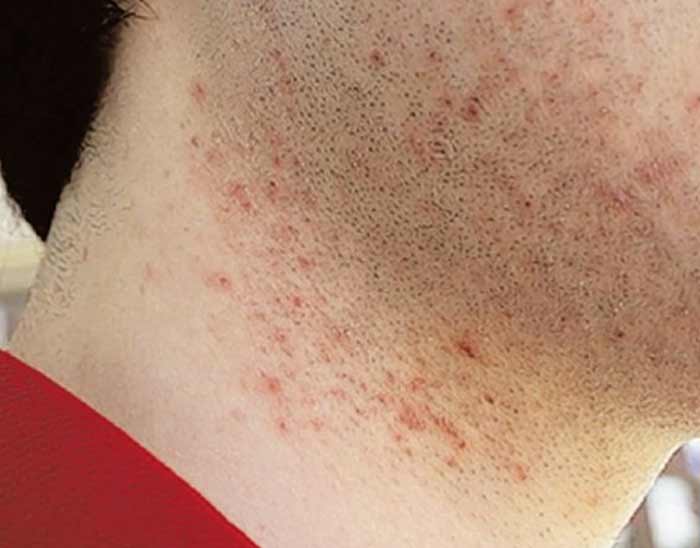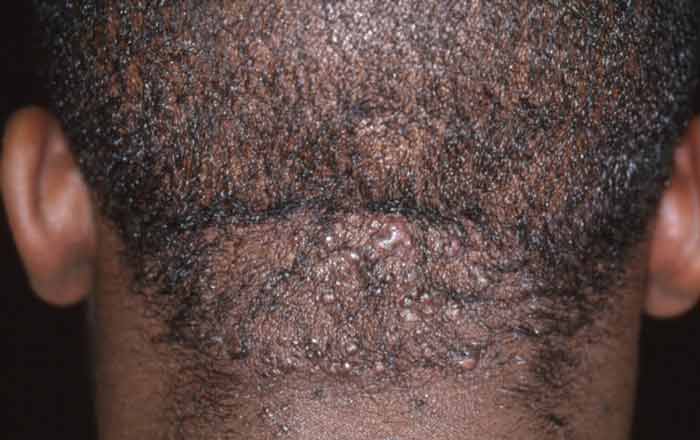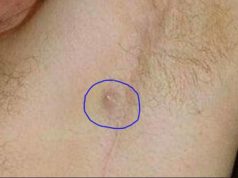In most cases Men are the obvious victims of ingrown hair on the neckline, both front and back of the neck especially after shaving/haircut. Of course, no one wants to be seen with the ugly bumps that hide the inward growing hair. Read on to find the likely causes, symptoms plus tips and ideas on how to get rid, prevent and treatment options
Ingrown Hair on Neckline Female-Likely Causes & Symptoms
Causes
Hirsuitism
This is a condition that is caused by various diseases. One common diseases is polycystic ovarian syndrome (PCOS). This is the most common cause by far. Small cysts develop around the ovaries. Other conditions that lead to hirsuitism includes Cushing’s syndrome, obesity, and congenital adrenal hyperplasia (Reference.com)
Too close a shave in women with excessive facial hair
Women with hirsuitism view the condition as a cosmetic and psychosocial problem than a disease. Hirsuite women rely on combination of mechanical hair removal and judicious use of medications (R S Rittmaster; Clinical review 1995)[1]. Therefore they become culprits of shaving as a cause of ingrown hairs. Too close shaving may result in abrasion or cuts that lead to razor burns.
Failure to use an after-shave after having a razor shave
As women who have facial hair can also have a shave, if they do not do it well then they can get ingrown hairs. After shaving requires that an appropriate cream is applied in order to exfoliate and remove hair follicles that are left on the skin.
Irritation by fungal infections
Fungal infections cause dryness on the skin of the neckline. This triggers scratching making it easier for the hair follicle to penetrate the skin and damage the cells. Failure to treat this condition also pre-exposes to ingrown hairs.
Failure to exfoliate the neckline
Hair might not be as much as that in hirsuitism, but it is there in small amounts. However, if you fail to use a facial scrub every once in a while, then you face the risk of accumulating many dead skin cells that clog the hair pores through which hair grows.
Curly hair
This hair has been mentioned as being one of the major causes of ingrown hairs in women who have facial hair and of the African-American origin
Symptoms
- Bumps of inflammation – inflammation occurs due to the reaction of your body’s immune system to the foreign body which is the ingrown hair. It wells, becomes red and warm.
- Itch – the urge to scratch is also a sign of this condition. Pseudofolliculitis barbae in both men and women results in itchiness. This poses a greater risk of infection when aggressively scratched.
- The bumps may be filled with either blood or pus – this is what gives the bump its characteristic color. If blood, then it is red and if pus it is green or yellow.
- Hyperpigmentation – this occurs contrary to the hypopigmentation when there is deposition of the protein keratin.
- Pain and tenderness – a streak of pain along the head in areas with the bumps is common and it becomes more painful when touched (hence tender).
- Lesions that look like blisters – if the bump is drainable and filled with clear fluid, the it is a blister.
- Bump with a black center
Pictures
Below are picture ingrown hair on neck, neck line and on back of the neck.
Picture #1
picture#2
Picture#3
Ingrown Hair on Back of Neck after Haircut & Shaving-Male
The reason men get the ingrown hairs in the neckline is due to improper shaving techniques. Here are some of the reason among others.
- Shaving too closely
- Shaving before wetting the skin
- The extent of care by the barber
- Failure to observe the after-shave rule
- Thick body hair
- Curly and coarse hair
- Shaving against the grain
Symptoms
The symptoms associated with ingrown hairs on the neckline are similar to those discussed in the previous section. Here they are:
- Inflammation causing bumps
- Pain and tenderness
- Black centered bump
- Itch around the bumps
- Lesions that are blisters
- Hyperpigmentation and scarring
- Discharge from the bump bearing a yellow or green color
How to get rid Ingrown Hairs on Neck- Male & Female
Removal
You can remove ingrown hair if you can be able to by yourself or with the help of someone else. The tools that are needed are a pair of tweezers, mirror, sterilizing agent, cotton wool, gauze and a pin. These are those required in a typical DIY setting.
You could go about removing it in the following ways:
- Start by treating the inflammation – this makes it easier to reach the embedded hair strand. Therefore, it prevents you from digging for the hair which might cause infections. The inflammation, when treated, also reduces the pain associated with the bump and the removal procedure. Treating inflammation involves the use of anti-inflammatory drugs (NSAIDs) or glucocorticoids.
- Use the warm compress methods to prepare the bump for removal. This procedure makes it easier to remove the hair embedded too just like the anti-inflammatories. By doing so, the bump can also be softened and drained for better visibility. This method basically involves dipping a washcloth in a bucket of hot water and when reasonably warm, is applied to the area of interest.
- Now clean the part of the skin you would wish to have the procedure done by using a mild antiseptic soap or alcohol swab.
- Sterilize your pin and tweezers to prevent infections then deploy the needle or pin in paving the way for the tweezers once you see the hair strand.
- Make sure that you do not remove the hair from its roots. Just remove the part of the hair shaft that is embedded.
- Use you cotton wool soaked in alcohol or alcohol swab to hold onto the area. This further prevents infections from taking advantage of the open lesion. Another disinfectant that can be used is dilute hydrogen peroxide or Povidone iodine.
Other removal methods such as mechanical epilation or surgical removal are best used when this simple procedure explained has not borne any fruits.
Further Reading:
Treatment/Medication
There are medications that increase the quality of life and also aid in the removal of the hair and these include:
Antibiotics – this class of drugs is to be prescribed if you have an infection. One way to know if you have an infection is by the discharge especially if it is colored.
The color of pus is either yellow or green. Antibiotics are effective against skin bug such as the Staphylococcus aureus which is the commonest cause of skin infections.
Exfoliation agents – these drugs include salicylic acid and glycolic acid. There are studies that have been done to prove the effectiveness of glycolic acid in treating pseudofolliculitis.
The results were positive and topical glycolic acid lotion is therefore an effective therapy (Perricone NV. Cutis, 1993)[2]. Benzoyl peroxide, which is an acne medication is also effective in the treatment of inflammation as well as exfoliation.
Anti-inflammatory agents – these include aspirin, ibuprofen and acetaminophen. They are effective in reducing the swelling association with inflammation.
Therefore, there is reduction in the redness and pain. It is more preferable to use ibuprofen and acetaminophen for this purpose as aspirin is a blood thinner.
If you have a wound that is bleeding, then it may be exacerbated by aspirin. Glucocorticoids that mat be used include hydrocortisone 1% cream. When applied twice in a day, morning and evening, it is effective in controlling inflammation (Crutchfield CE 3rd.Cutis. 1998)[3].
Home Remedies
Sugar glycolic acid and olive oil
As detailed in the treatment section, glycolic acid is known to be a good exfoliating agent. It is also a potent antibiotic. You can derive glycolic acid from creams that have this content but you can as well get some from your kitchen.
One source is sugar. White sugar in particular. The glycolic acid in sugar is enough to reduce the inflammation, fight infection and at the same time, exfoliate your skin.
To make this scrub, mix an equal amount of sugar with an essential oil such as olive oil. Olive oil does not contain any damaging chemicals (Huffington Post)[4] and contains oleic acid which aids penetration of nutrients. These nutrients allow the cells of the skin that were damaged to rejuvenate.
Black tea bags
In black tea, there is a substance known as tannic acid (Saunders 2008)[5]. It is a natural anti-inflammatory that soothes your skin. It reduces the irritation and is therefore an anti-pruritic.
To use this, just apply some to the skin on which you have the bumps and rub. This will help in not only reducing the itch, but also preventing further complication through scratching.
Recent studies have concentrated on the antitumor activity of tannins (M. Ken-ichi er ul., Biol. Pharnt. Bull. 1993, 16.379) and this is good in reducing the ‘tumor’ associated with inflammation. Tannic acid is used as an astringent and styptic. This also helps the skin cells recover.
Tea tree oil remedy
Tea tree oil has anti-inflammatory properties. It is also an antiseptic. This therefore means that it would be beneficial in keeping the pathogens in check.
Dilute close to 5 drops of tea tree oil with an equal part of water. Apply on the area on the neckline with ingrown hair bumps. Leave to stay for 10 minutes then rinse it off with warm water.
Deep ingrown hair on neck won’t go away-what to do
If your ingrown hair does not give in, then it is suggested that you seek professional support from a dermatologist. The dermatologist may recommend surgical removal. Fortunately, they are well equipped with the necessary tools to easily remove it. You may have to incur a cost if it is recurrent or persistent.
How to stop Ingrown Neck Hair-Prevention Tips & Ideas
To prevent ingrown hair on the neckline;
- Shave less frequently and in the direction of the hair growth.
- Ensure your razor is clean and sharp.
- Exfoliate your neckline skin to unclog the skin pores at least thrice in a week.
- Apply moisturizers often to hydrate your skin
- Use an aftershave to remove remnants of hair cut
- Do more of trimming than shaving
Sources
[1] R S Rittmaster; Clinical review 73: Medical treatment of androgen-dependent hirsutism. J Clin Endocrinol Metab 1995; 80 (9): 2559-2563. doi: 10.1210/jcem.80.9.7673394
[2] Treatment of pseudofolliculitis barbae with topical glycolic acid: a report of two studies. Perricone NV.Cutis. 1993 Oct; 52(4):232-5.
[3] Crutchfield CE 3rd.Cutis. 1998 Jun; The causes and treatment of pseudofolliculitis barbae. 61(6):351-6.
[4] http://www.huffingtonpost.com/zester-daily/choosing-olive-oil_b_3830641.html
[5] Trease and Evans Pharmacognosy by Saunders, 2008 Ed.






